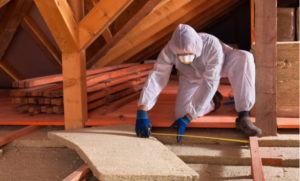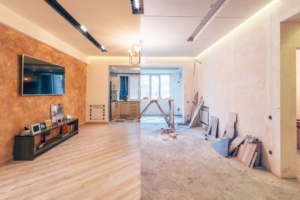Handyman Naperville IL is a person with a broad range of repair and maintenance skills. They work in both residential and commercial properties.
They often work with plumbers, electricians, building systems technicians and locksmiths. If a job requires specialized skill sets, they will recommend someone who is licensed in that area.

Maintaining a home can be a time-consuming, stressful task. If you have a long list of tasks to complete, hiring a handyman is an excellent choice. These professionals save you time by taking care of all of your repair and maintenance needs. In addition, they are well-equipped with the skills and tools necessary to get the job done quickly and efficiently.
If you’re a busy professional, finding the time to tackle home repairs can be challenging. You can save yourself a great deal of stress by hiring a professional to handle the work. Not only will you save yourself time, but you’ll also be able to focus on your other duties and responsibilities.
A good handyman will have experience in various specialisms, so you can trust that they’ll be able to handle most any type of job. They may even be able to offer advice on how to do the work yourself, saving you further time and hassle. If you need help with a specific project, hiring a handyman can be much more cost-effective than hiring multiple contractors.
Many handymen are independent contractors, which means they must pay for their own equipment and supplies. In turn, they pass these savings on to their clients. Whether you need help with basic repairs, or more complex installation projects, handymen can provide the solutions you need at competitive rates.
Handymen often negotiate discounts with material suppliers, which allows them to pass on those savings to their customers. This can save you money on expensive supplies such as floor sanders and post-hole diggers that you might not need on a regular basis.
A good handyman has an eye for detail that can spot problems that you might overlook, potentially preventing bigger issues down the line. They can also help you plan your home improvement projects, ensuring that they’re completed in a timely and efficient manner.
Handymen are also usually available at a variety of times, making them easier to schedule than specialized contractors or tradesmen. They can often come to your home or business after hours, so you won’t have to worry about interrupting your day-to-day operations.
Saves You Money
While tackling a few minor repairs on your own might seem like an inexpensive solution, it can end up costing you more in the long run. Handymen can identify repair issues before they become more severe, saving you money in the future.
In addition, hiring a skilled professional saves you money on labor. A skilled handyman can perform a wide range of tasks, from plumbing and electrical work to carpentry and painting. This eliminates the need for you to hire multiple contractors for each individual task, which can be expensive.
Additionally, a handyman comes prepared with all of the necessary tools for each job, saving you money on rental fees. You can also save on materials by working with a professional, as they typically have access to bulk supplies and discounts on materials.
Another way that a handyman can save you money is by providing a variety of services in one visit. This includes fixing a leaky faucet, installing ceiling fans and repainting the living room. This eliminates the need for you to make numerous trips to the hardware store and saves you time on your commute.
Most handymen are licensed and insured, which protects you as a customer. This ensures that they follow industry standards and are properly trained for each job. It also helps you avoid paying for additional services that may not have been included in the original quote.
As a handyman, it’s important to keep in mind that many clients will have different expectations and budgets. Discussing these upfront with your client can help you build trust and develop a long-term relationship. It can also prevent any misunderstandings that could lead to costly mistakes.
While it’s possible to start a handyman business without insurance, it’s not recommended. General liability insurance protects you from claims against your business for property damage and bodily injury. It’s also an excellent way to show your customers that you take their safety seriously.
In addition to liability insurance, a handyman should have workers compensation and general business insurance. These policies can cover injuries and accidents that occur while the handyman is on the job. They can also cover the cost of any materials that are damaged or stolen during a job.
Saves You Energy
A handyman’s typical job description includes completing repair and maintenance tasks, but there are many ways in which they can also help you save energy. Inefficient windows, doors and insulation can lead to sky-high heating and cooling costs. However, a professional handyman can install double-pane windows, seal air leaks and install energy-efficient light bulbs to reduce your electricity bills.
A good handyman will take the time to listen to your concerns and goals so that they can suggest the best solutions for your home. For instance, if your energy bills are rising due to an inefficient boiler or heating system, a handyman will install a more efficient model or repair the existing one.
In addition, a handyman can also help you save on your electrical bills by installing light timers or motion sensors that will automatically switch off lights when nobody is around. They can also install new insulation to prevent heat loss and improve the efficiency of your home’s plumbing systems and appliances.
The main difference between a handyman and a contractor is that contractors usually have stricter licensing requirements and are experts in a specific trade, while handymen have general knowledge of several different trades and can complete many types of projects at low to medium cost and difficulty levels. Handymen also often work with a team of professionals, including electricians, plumbers and carpenters.
If you are looking for a handyman who will be honest and trustworthy, you should always choose someone with whom you can build a long-term relationship. Handymen who are dependable and have good customer service skills are likely to be well-liked by their clients, which can help them develop their business.
When choosing a handyman, be sure to check whether they are licensed and insured. Generally, handymen are required to carry general liability insurance, which will protect you in the event of an accident or damage caused by their work. In addition, you should also check with your state’s regulations regarding what jobs a handyman can legally do. There are also some states that require handymen to obtain a license for certain types of work, such as building large structures or performing electrical and plumbing services.
Saves You From Mistakes
Handymen can identify issues that could turn into big problems in the future. They’ll take care of minor repairs and preventative maintenance before they get out of hand, saving you money in the long run. Handymen also have experience working on a wide variety of projects, from electrical to painting to carpentry.
When you hire a reliable handyman, you can rest assured that the job will be done correctly. The right tools will be used, and the proper safety measures will be taken to protect your property. Additionally, a skilled handyman can complete tasks quickly and efficiently. This can save you time, which can be especially valuable in a pinch.
Many homeowners and small businesses encounter emergency situations that require immediate attention. From a burst pipe flooding a basement to a faulty air conditioning unit during a heatwave, these situations demand expert help. Handyman services are the go-to solution for such situations.
While some states require a license to work as a contractor, most handymen don’t have any formal education or training. However, some vocational schools and community colleges offer practical courses in specific trades.
A key skill handymen have is improvisation. For instance, if the necessary replacement part for a broken item isn’t immediately available, a handyman will improvise a makeshift solution until it arrives. They’ll also explore repair options before suggesting a replacement, such as reinforcing loose hinges or repairing a broken drawer.
The popularity of handyman services is reflected in the many television shows and movies that feature this type of professional.



